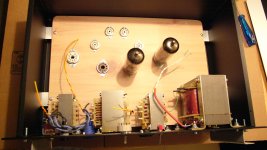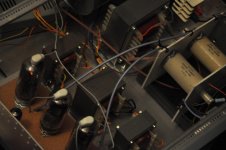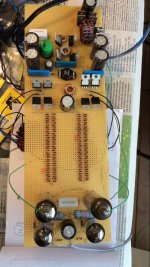The paper is posted on the Beveridge web site but most of the images are missing. If anyone here has the whole document would you be so kind as to post it here? Thanks very much.
white_paper
white_paper
I could tell you if i had a chance to listen to all the speakers out there, but yes, they are special. I usually listen to my Acoustat ESL's as these can produce the sound pressure levels i need for the life experience. The Bev's have the "magic" of not being there at all (you can put your ear against one and still hear stereo). But they do have a "color" and this is less with the Acoustats or any other full range ESL i know. This because they are "boxed". This "color" is not annoying but if you look for the ultimate colorless speaker it will not be your choice. However the spacious sound is unequaled. I have heard the Bev's the first time in 1986 or so and knew directly what kind of loudspeaker i wanted "when i grow up" as these where out of my league at that time (i owned B&W Model 70 at that time). Later i found the Acoustats and never looked back. These have another important advantage of the Bev's, they do not break!
The Bev's are weak in construction, especially the panels and power transformers(compared to the Acoustats). The amps need to be rebuild (this is true for the Acoustats as well), but when being in good condition they are magical. If you have a chance to audition them i would sure recommend it!
The Bev's are weak in construction, especially the panels and power transformers(compared to the Acoustats). The amps need to be rebuild (this is true for the Acoustats as well), but when being in good condition they are magical. If you have a chance to audition them i would sure recommend it!
Attachments
I could tell you if i had a chance to listen to all the speakers out there, but yes, they are special. I usually listen to my Acoustat ESL's as these can produce the sound pressure levels i need for the life experience. The Bev's have the "magic" of not being there at all (you can put your ear against one and still hear stereo). But they do have a "color" and this is less with the Acoustats or any other full range ESL i know. This because they are "boxed". This "color" is not annoying but if you look for the ultimate colorless speaker it will not be your choice. However the spacious sound is unequaled. I have heard the Bev's the first time in 1986 or so and knew directly what kind of loudspeaker i wanted "when i grow up" as these where out of my league at that time (i owned B&W Model 70 at that time). Later i found the Acoustats and never looked back. These have another important advantage of the Bev's, they do not break!
The Bev's are weak in construction, especially the panels and power transformers(compared to the Acoustats). The amps need to be rebuild (this is true for the Acoustats as well), but when being in good condition they are magical. If you have a chance to audition them i would sure recommend it!
Hello Lampie,
I agree on some of your points. Firstly, the Beveridge interpretation is very unique and certainly, even to this day, are competitive with other other electrostatics in their abilities.
I have owned many of the Acoustat models included the Model X , Model 3 , 2+2 etc. They can play louder for certain. I feel they are not as transparent as the Beveridges. For the truest purity IMO it is the Quad ESL - others not even close- but they have other limitations.
The construction of the Beveridge cabinet is certainly not its strong point- but this can be largely corrected.
As to the transformers etc. Sure, I have had a failure on the HV on one of mine but these speakers are over 40yrs old. There are solutions. Ask Martin Logan CLS users of their step up transformer problems.
As to the panels I would suggest they are more robust than most electrostatics by virtue of their unique approach to design and low impedance foil.
I have gone direct drive with my model 3s and this is transformational... the compromises made with a stepup and crossover are eliminated and catapults this speaker to a different level. If you can do this then I believe you might agree that the ledger falls in favour of the Beveridge.
I love the Acoustats too, however, it is all a matter of priorities and what you value and the ability you have to modify and take a very unique design a little past the limitations of a commercial product.
Cheers
I have rebuild the amps for the Bev's and the Acoustats (all tube) and these are stable for more then 10 years now. Yes, the old Quads are very nice indeed but can not give you a full range experience (sub bass experience) as the Acoustats can. I do not listen to ESL's with step up transformers anymore as these can not even come close to a direct driven ESL. I like the way the Beveridge panels work but only the older (aluminium frames) panels are stable not the plastic (blue frames) ones. They are a difficult to refurbish (diy). If you know a trick how to do this i would like to know as i have some that need new foils.
I use in my main listening room a set of Model 4 plus a set of 1+1 and some additional panels. These all can be driven by 2 amps only.
I use in my main listening room a set of Model 4 plus a set of 1+1 and some additional panels. These all can be driven by 2 amps only.
Hi Lampie, thanks for your reply. About 20 years ago, I used to own a pair of Acoustats, with the direct drive tube amps. Back then I had the home / room big enough for them. I modified the amps using extra B+ reservoir capacitors, changed the quad op-amp to one I thought was better and had the measurement equipment to see the HV value (4kV?).
Around that time a long term relationship ended, I met someone new, had a kid and worried about a toddler going "back there" where these amps were - I had the amps, but not the cages. I believe I came into possession of a large McIntosh solid state amp and probably tried that through the conventional step-up arrangement that were part of the bases. Eventually I parted ways with all of it, as part of a sell off and start over, possibly coincident with moving into a different home.
More recently I had a burning chunk of change and thought I'd audition a local pair of MLs I could make a reasonable offer on. The guy had lots of modern Mac equipment to drive them with. For some reason, I couldnt wrap my senses around anything he played for me; they just didnt do it - I couldnt locate anything in the soundstage (with his family eating dinner behind me) - so I declined and thanked him for his time. Now, I'm back to FR point source speakers.
Can one's audio perception be so thoroughly trained that something presenting a non square law decrease in amplitude vs distance sound just doesnt sound so right? What does that brand of physics do to the nearfield? I'm wondering if I'm so familiar with point source or very near point source, that it may take lots of time / listening to "unlearn" the anomalies of that sound to where I can again appreciate di-pole ESLs and what they do?
I seriously doubt a pair of Beveridge speakers will ever be within my means in this life, but I'm still curious about their claims and do believe the guy was right-on, that's why I asked about it. Whether any other mono-pole line array speaker (within my means) can approach what they do remains to be seen. Thanks!
Around that time a long term relationship ended, I met someone new, had a kid and worried about a toddler going "back there" where these amps were - I had the amps, but not the cages. I believe I came into possession of a large McIntosh solid state amp and probably tried that through the conventional step-up arrangement that were part of the bases. Eventually I parted ways with all of it, as part of a sell off and start over, possibly coincident with moving into a different home.
More recently I had a burning chunk of change and thought I'd audition a local pair of MLs I could make a reasonable offer on. The guy had lots of modern Mac equipment to drive them with. For some reason, I couldnt wrap my senses around anything he played for me; they just didnt do it - I couldnt locate anything in the soundstage (with his family eating dinner behind me) - so I declined and thanked him for his time. Now, I'm back to FR point source speakers.
Can one's audio perception be so thoroughly trained that something presenting a non square law decrease in amplitude vs distance sound just doesnt sound so right? What does that brand of physics do to the nearfield? I'm wondering if I'm so familiar with point source or very near point source, that it may take lots of time / listening to "unlearn" the anomalies of that sound to where I can again appreciate di-pole ESLs and what they do?
I seriously doubt a pair of Beveridge speakers will ever be within my means in this life, but I'm still curious about their claims and do believe the guy was right-on, that's why I asked about it. Whether any other mono-pole line array speaker (within my means) can approach what they do remains to be seen. Thanks!
Last edited:
Hello Joe, surely there are other loudspeakers that can give a similar experience. Please do not forget that the amp is as important as the speaker. If you have the chance try a Zotl amp (i am a big fan). You will find that dynamic loudspeakers can sound equally good as electrostatics when driven correctly. I know it sounds unlikely, just give it a try! I have to agree that once you had an encounter with a “correct” sound you will never be happy with something less. Plus you will never forget that experience. It is a dilemma haha.
I seriously doubt a pair of Beveridge speakers will ever be within my means in this life...
Don't be so sure. I bought a pair of Model 5s for $800, and am awaiting delivery of a pair of Model 3s for which I paid $2,000. Yes, they are old and likely will need work (the 3s do -- see my thread on the topic).
These days I don't think that's a lot of money for what the Bev is.
Don't be so sure. I bought a pair of Model 5s for $800, and am awaiting delivery of a pair of Model 3s for which I paid $2,000. Yes, they are old and likely will need work (the 3s do -- see my thread on the topic).
These days I don't think that's a lot of money for what the Bev is.
I have rebuild the amps for the Bev's and the Acoustats (all tube) and these are stable for more then 10 years now. Yes, the old Quads are very nice indeed but can not give you a full range experience (sub bass experience) as the Acoustats can. I do not listen to ESL's with step up transformers anymore as these can not even come close to a direct driven ESL. I like the way the Beveridge panels work but only the older (aluminium frames) panels are stable not the plastic (blue frames) ones. They are a difficult to refurbish (diy). If you know a trick how to do this i would like to know as i have some that need new foils.
I use in my main listening room a set of Model 4 plus a set of 1+1 and some additional panels. These all can be driven by 2 amps only.
Hi there,
I agree that the carbon element aluminum frame panels are the ones to have with the Beveridge. I have never encountered the plastic panels but understand they are not as robust.
Once you go direct drive it is impossible to go back to a transformer coupled electrostatic.
I found this forum with some nice information on this topic:
AnsaHT.com :: Leggi argomento - BEVERIDGE
and:
Beveridge: my favourite loudspeakers
AnsaHT.com :: Leggi argomento - BEVERIDGE
and:
Beveridge: my favourite loudspeakers
Last edited:
Hi to all,
thanks for all information of previous posts regarding the Beveridge Model 2 and Model 2SW speakers and amplifiers. I also have a pair 2SWs I got some years ago from Amsterdam and I'm desperately dependent from their sound. It has a bit of an addicted's habbit. Sometimes I just wonder the music is centred around the speakers and not, well, I must childishly admit "real".
Anyway, one panel was broken. I found someone to repair it with new mylar. I put the panel back in. All is well. Exept the transformer hum that's now considerably lower than the hum of the other speaker that didn't have the broken panel.
So the old question came back how to get rid of the hum completely. It must be wonderful to get that sound without any hum. My idea is to replace the transformers with torroidal ones or even more exotic version. Is this the way to go? What are the transformer's data?
I read one of You replaced the amps completely. Since I like ZOTLs also, I asked David Berning yet whether it would be possible to drive a model 2 by his ZH270 amplifier directly. But I didn't dare yet to change anything with the speakers. So how to get rid of the hum?
Thanks to all, have a good Sunday!
Adrian
thanks for all information of previous posts regarding the Beveridge Model 2 and Model 2SW speakers and amplifiers. I also have a pair 2SWs I got some years ago from Amsterdam and I'm desperately dependent from their sound. It has a bit of an addicted's habbit. Sometimes I just wonder the music is centred around the speakers and not, well, I must childishly admit "real".
Anyway, one panel was broken. I found someone to repair it with new mylar. I put the panel back in. All is well. Exept the transformer hum that's now considerably lower than the hum of the other speaker that didn't have the broken panel.
So the old question came back how to get rid of the hum completely. It must be wonderful to get that sound without any hum. My idea is to replace the transformers with torroidal ones or even more exotic version. Is this the way to go? What are the transformer's data?
I read one of You replaced the amps completely. Since I like ZOTLs also, I asked David Berning yet whether it would be possible to drive a model 2 by his ZH270 amplifier directly. But I didn't dare yet to change anything with the speakers. So how to get rid of the hum?
Thanks to all, have a good Sunday!
Adrian
Here are two slightly different versions of the white paper I had archived.The paper is posted on the Beveridge web site but most of the images are missing. If anyone here has the whole document would you be so kind as to post it here? Thanks very much.
white_paper
Attachments
Hi Lampie519!
Just id read Your post about Beveridge ESLs... and ZOTLs. I use a Berning ZOTL with Quad ESL57, it's fantasic, but too soft. But Model 2 SW by Beveridge is much better. Anyway, I'm fed up with the transformator's hum, it easily interfers with soft music. So I asked David Berning if one could drive Model 2 directly. He was very friendly and told me all kinds of stuff and first off all, to get an amplifier ZH270 which has the voltage needed. Do You know someone who can do the work on the ZH270, especially, to get the right points to get the voltage out?
Thanks and best regards,
Adrian
Just id read Your post about Beveridge ESLs... and ZOTLs. I use a Berning ZOTL with Quad ESL57, it's fantasic, but too soft. But Model 2 SW by Beveridge is much better. Anyway, I'm fed up with the transformator's hum, it easily interfers with soft music. So I asked David Berning if one could drive Model 2 directly. He was very friendly and told me all kinds of stuff and first off all, to get an amplifier ZH270 which has the voltage needed. Do You know someone who can do the work on the ZH270, especially, to get the right points to get the voltage out?
Thanks and best regards,
Adrian
Here is the schematic, on the last page.
http://davidberning.com/images/zh270/ZH270_Manual.pdf
http://davidberning.com/images/zh270/ZH270_Manual.pdf
You will need a seperate HV source for the ESL's. The anodes of the output tubes can be connected to the speakers with a filter network and some HV capacitors. Not sure if the voltage swing will be sufficiant to drive the speakers loud enough for you, but it will work ( i tried it already with my Acoustats).
- Status
- This old topic is closed. If you want to reopen this topic, contact a moderator using the "Report Post" button.
- Home
- Loudspeakers
- Planars & Exotics
- Do any of you have the old Beveridge 'White Paper'?


